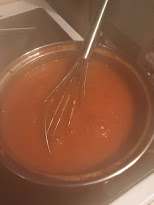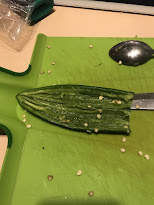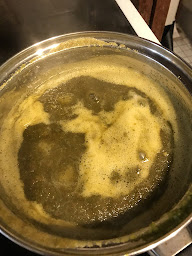
Another busy Sunday morning of preserving should see me testing out my homemade Kimchi in time for next weekend. Again I have used the incite and descriptions from LifebyMikeg on instagram to get the basic recipe and then run with it. Another preserved food that hopefully helps with the growth of good bacteria to give the body overall health and well-being.
As you can no doubt tell I am really getting into preserving and also just the why buy processed supermarket style if you can do it yourself. The way I see it by making it yourself you can control what goes into your food and by doing so limit the intake of dodgy additives in your daily diet. A recent visit to the Doctor and a blood test or 2 later and I found out that my Cholesterol was on the high side. The Doctor has given me six months to get it right through diet and exercise and then if I can't make the changes I'll have to start popping pills to fix the problem. The way I see it, at age 46 I can either use this as a motivation for change or join the masses in becoming a medicated member of society. The choice is simple. The diet part of the equation has to include improved gut health and preserved foods like kimchi and sauerkraut with their active good bacteria are part of the journey.
So before I get too bogged down let's get to the recipe...
Ingredients :
2 large Chinese Cabbages
Salt
4 small red apples (peeled and cored)
½ Daikon Radish
4 tablespoons Korean Red Pepper Powder
Fish Sauce
4 Tablespoons of Glutinous rice flour
1 Litre of water
4 cm knob of Ginger
4 cloves Garlic
Description:
1. First thing is to cut up your cabbages by slicing across the leaves at 2 cm intervals to evenly slice the leaves. Once sliced up season very generously with salt, cover with a couple of dinner plates or other weighted item to apply pressure to your cabbage and force out the liquid. Leave to stand overnight. Whilst I originally had the cabbage in a stockpot and a large mixing bowl after a few hours I was able to transfer it all to the stockpot and weight it down with 2 dinner plates and cover with the lid of the stockpot to prevent the chance of any unwanted things getting into the cabbage.
2. Onto the fun stuff. Rinse the cabbage with water to wash off the salt and then drain thoroughly. I used a salad spinner to help with the drying. Dice up your apple and shred or grate the radish. Place the diced apple in water to stop the browning. I used the a green papaya shredded to shred the radish but you could just grate or even dice the radish.
3. Peel garlic and ginger and whizz in a food processor to a fine mince.
4. Add the water and flour to a saucepan and whisk enthusiastically to dissolve the flour in the water to form a white paste. Add in the ginger and garlic and whisk to mix through. Add in the Korean Chilli powder to form a thick red paste. This paste is what gives the kimchi it's distinctive red colouring. Allow to cool, at least enough so that you are able to mix it with the cabbage without either cooking the cabbage or possibly more importantly, burning your hands.
5. Now put the apple cabbage and radish together in large bowl. Pour over the red paste and mix thoroughly so that the cabbage is evenly coated.
6. Once done transfer the kimchi to large jars to let the preserving begin. I have heard that the preserving takes between 3 and 7 days but as this is my first time making I will have to wait and see what is successful. Each day during the preserve I will be forcing the cabbage down into the jars to make sure that the cabbage is fully submerged. In fact after about the first 4 hours I will be using the Pestle from my Thai Green Papaya Krok to force the cabbage beneath the surface of the kimchi liquid. As the jars will be sealed I will need to remove the lids each day to allow gas to escape and prevent the reactions from causing breakages to the glass jars.
Whilst we are all wondering when we will see an end to Covid and and restrictions on our lifestyles it is great to be able to spend the time indoors doing something productive and who knows, maybe I can turn this into a business that one day pays the bills. Until then it is just a fun way to spend a Sunday. Happy cooking!!!

























